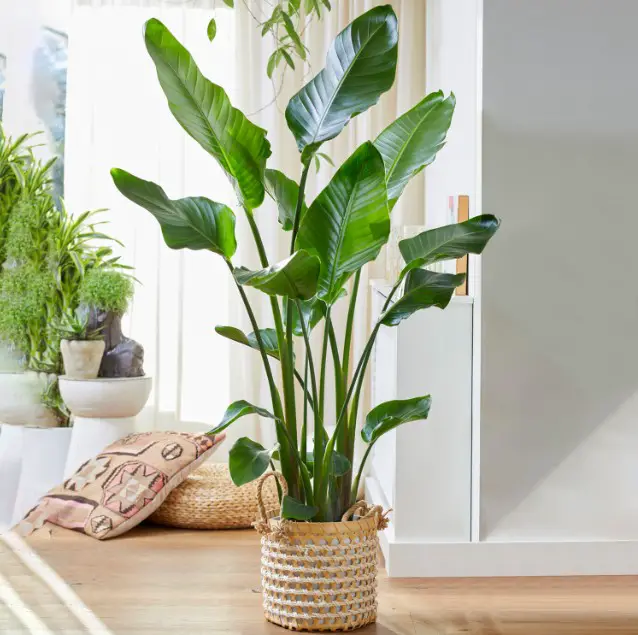The Strelitzia Nicolai, also known as the Giant White Bird of Paradise, is a stunning tropical plant native to South Africa. Its large, banana-like leaves and striking white and blue flowers make it a popular choice for both indoor and outdoor gardens.
Although this plant is often associated with warm, humid climates, it can thrive indoors with the right care and attention. In this detailed guide, we will cover everything you need to know about caring for and growing Strelitzia Nicolai to ensure it thrives in your home or garden.
Overview of Strelitzia Nicolai
- Common Name: Giant White Bird of Paradise
- Botanical Name: Strelitzia nicolai
- Family: Strelitziaceae
- Plant Type: Herbaceous perennial
- Mature Size: 6-10 ft. tall (indoors), up to 30 ft. tall (outdoors)
- Sun Exposure: Full to partial sunlight
- Soil Type: Well-draining, loamy soil
- Soil pH: Slightly acidic
- Bloom Time: Spring to early summer
- Flower Color: White and blue
- Hardiness Zones: 10-12 (USDA)
- Toxicity: Toxic to pets
Strelitzia Nicolai Care Requirements

To cultivate healthy Strelitzia Nicolai, you must replicate its natural tropical habitat as closely as possible. Below, we break down the specific care requirements.
Light
Strelitzia Nicolai thrives in bright, indirect light. When grown indoors, place it near a window that gets ample light throughout the day. It can tolerate some direct sunlight, especially during the cooler hours of the day, but too much harsh, direct sunlight can scorch its leaves. A room with east or west-facing windows is ideal.
If you are growing it outdoors, it prefers full sun to partial shade. In colder climates, this plant should be moved indoors during winter months.
Soil
This plant prefers well-draining, loamy soil. If you are growing Strelitzia Nicolai in a pot, use a high-quality potting mix with good drainage. To improve drainage, consider adding perlite or sand to the soil. Ensuring the soil drains well is crucial, as this plant is susceptible to root rot if left in waterlogged soil for too long.
For outdoor growth, it thrives in fertile, slightly acidic soil. If you are planting it in the ground, make sure the soil is amended with organic matter to improve its texture and nutrient content.
Watering
Proper watering is one of the most critical factors in caring for Strelitzia Nicolai. This plant enjoys consistently moist soil but does not like to sit in water. Water the plant thoroughly, allowing excess water to drain out, but ensure the soil dries out slightly between waterings.
During the growing season (spring and summer), you will need to water more frequently—typically once a week or when the top inch of soil feels dry. In fall and winter, reduce watering as the plant enters a dormant phase.
Temperature and Humidity
As a tropical plant, Strelitzia Nicolai prefers warm temperatures and high humidity. The ideal temperature range for indoor growth is between 65°F and 80°F (18°C to 27°C). It is sensitive to cold temperatures and should not be exposed to temperatures below 60°F (15°C) for prolonged periods. If grown outdoors, it is best suited for USDA zones 10 to 12.
To increase humidity around your plant, you can mist the leaves regularly or place a humidifier nearby. Alternatively, placing the pot on a tray filled with water and pebbles can help maintain a humid environment.
Fertilizer
Strelitzia Nicolai is a heavy feeder and requires regular fertilization during the growing season. Use a balanced liquid fertilizer or slow-release pellets to provide essential nutrients. Fertilize the plant every two weeks from early spring through late summer. As the plant enters dormancy in the fall and winter months, you can stop fertilizing.
Pruning and Maintenance
Pruning your Strelitzia Nicolai is essential for maintaining its appearance and encouraging healthy growth. Remove dead or damaged leaves by cutting them close to the base of the plant. This helps prevent the spread of disease and pests.
As the plant grows taller, you may also need to thin out the foliage to allow for better air circulation, which can reduce the risk of mold or fungal infections. Use clean, sharp pruning shears, and always sterilize your tools between uses to prevent the spread of disease.
Repotting
Strelitzia Nicolai is a fast-growing plant and will need to be repotted every 1-2 years, especially when grown in a pot. Repot the plant into a slightly larger container to accommodate its expanding root system. Use fresh potting soil each time you repot to ensure the plant receives the necessary nutrients.
Once your plant has reached its desired size, you can limit repotting to every 2-3 years. Be mindful that a slightly root-bound plant will bloom more readily, so avoid repotting too often.
Propagation of Strelitzia Nicolai
You can propagate Strelitzia Nicolai by division or growing it from seeds. The division method is quicker and more reliable, whereas growing from seeds requires more time and patience.
Propagating by Division
The best time to divide Strelitzia Nicolai is during spring, just before the growing season begins. Here’s how to do it:
- Gently remove the plant from its pot.
- Identify sections of the plant with healthy roots and at least three leaves.
- Using a sharp knife, carefully cut through the root system to separate the divisions.
- Plant each division in its own pot with fresh, well-draining soil.
- Water thoroughly and place the divisions in a warm, bright location.
Propagating by Seeds
Growing Strelitzia Nicolai from seeds is more challenging but possible with the right steps:
- Soak seeds in water for 24-48 hours.
- Nick the seed coat with a sharp knife to encourage germination.
- Plant the seeds in a potting mix about 1 inch deep.
- Place the pot in a warm location with indirect sunlight and cover it with plastic wrap to retain moisture.
- Keep the soil moist, and be patient, as germination can take 1-2 months.
Once the seedlings have developed two to three leaves, they can be transplanted into larger pots.
Common Problems and Solutions
While Strelitzia Nicolai is a relatively low-maintenance plant, it can encounter a few common issues. Here’s how to address them:
Yellowing Leaves
Yellow leaves often indicate either overwatering or a lack of nutrients. Make sure you are not watering too frequently and that the plant is getting enough sunlight and fertilizer. If the problem persists, check the roots for signs of root rot.
Brown Leaf Edges
Brown leaf edges are usually caused by low humidity or underwatering. Mist the plant regularly or increase humidity with a humidifier to resolve the issue.
Pests
Common pests that affect Strelitzia Nicolai include aphids, spider mites, and scale insects. Regularly inspect the plant for pests, and if necessary, treat with insecticidal soap or neem oil.
Root Rot
Root rot is a fungal disease that occurs when the plant is overwatered. To prevent root rot, make sure the soil drains well and allows the top layer to dry out between waterings. If root rot has already set in, you may need to trim away the affected roots and repot the plant in fresh soil.
How to Get Strelitzia Nicolai to Bloom
Strelitzia Nicolai is known for its large, bird-like white and blue flowers. However, getting this plant to bloom indoors can be a challenge. To encourage flowering, make sure your plant is receiving enough bright light (at least 6 hours a day) and is slightly root-bound. Fertilize regularly during the growing season, and avoid repotting too often, as a pot-bound plant is more likely to bloom.
Conclusion
Strelitzia Nicolai is a majestic and rewarding plant that can bring a touch of the tropics to any home or garden. With its dramatic foliage and striking flowers, it makes a bold statement wherever it is placed. By following the care guide outlined above, you can ensure that your Strelitzia Nicolai thrives and remains a beautiful addition to your plant collection. Whether you are growing it indoors or outdoors, this resilient plant is sure to impress.






